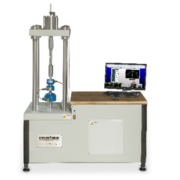The Textile Industry’s Future Demands Force Measurement Solutions
 The textile industry is undergoing rapid transformation driven by increasing demand and the imperative for modernization. It involves complex manufacturing processes, including spinning, weaving, finishing, and dyeing, as well as the intricate design and maintenance of heavy-duty industrial machinery that can withstand continuous use.
The textile industry is undergoing rapid transformation driven by increasing demand and the imperative for modernization. It involves complex manufacturing processes, including spinning, weaving, finishing, and dyeing, as well as the intricate design and maintenance of heavy-duty industrial machinery that can withstand continuous use.
Textiles are integral to our everyday lives, whether the comfort of clothing, textile functionality, or fashion’s creative expression through innovative textile inventions and IoT wear.
Despite the booming market for textile machinery fueled by automation and innovation, many manufacturers still rely on outdated equipment. This discrepancy presents a critical gap that Interface force measurement solutions are uniquely positioned to fill.
By retrofitting existing equipment with load cells, textile manufacturers can gain valuable insights into their processes, optimize production, improve fabric quality, and extend equipment life.
Why the Textile Industry Must Embrace Advanced Force Measurement Solutions Now
- Streamlined Modernization: Retrofitting existing machinery with advanced load cells offers a cost-effective avenue to gain a significant competitive advantage. These solutions can seamlessly integrate into legacy hardware, revitalizing older machines and unlocking invaluable data streams.
- Precision for Flawless Fabrics: Inconsistent yarn tension perpetually threatens fabric quality. Traditional tension monitoring methods are subjective and prone to inaccuracies. Advanced load cell technologies enable continuous, real-time tension monitoring, facilitating precise adjustments and optimizations that produce consistently high-quality fabrics.
- Enhanced Production Efficiency and Reduced Downtime: Incorrect winding or unwinding tension can lead to fabric distortion, breakages, and equipment damage. Advanced sensors provide precise data for automated tension control, minimizing defects and prolonging equipment lifespan. This optimization ultimately boosts production efficiency while reducing costly downtime.
- Informed Maintenance Strategies: Historically, determining machine load capacity has been speculative. Pairing Interface load cells with advanced instrumentation offers real-time insights, enabling proactive maintenance based on actual usage data. This approach maximizes equipment lifespan and minimizes unnecessary maintenance expenses.
- Weaving Efficiency on Autopilot: Inefficient warp tensioning disrupts weaving processes, resulting in fabric irregularities and production losses. Integrating sensors into warp beams or tensioning mechanisms enables automated control, ensuring optimal tension for efficient weaving, reduced yarn breakage, and increased output. Check out Weave Loom Efficiency.
Interface force, torque, and weight measurement devices are valuable tools that can revolutionize the textile industry. By embracing this cutting-edge technology, manufacturers can unlock valuable process insights, enhance production for unparalleled efficiency, ensure consistency in fabric quality, extend equipment use, and significantly reduce maintenance costs.
Weave Loom Machine Optimization with Wireless Load Pin Load Cells
A weaving loom machine is a device used to create woven fabric by interlacing threads or yarns at right angles to each other. A real-time tension monitoring system is needed to ensure the tension of the material is perfect to create optimal weave efficiency. Instead of the traditional beam, Interface suggests integrating WTSLP Wireless Stainless Steel Load Pins into the beam. The WTSLPs capture the tension results in real-time and send the data to the customer’s PC through the WTS-BS-4 Industrial USB Base Station with supplied Log100 software. Learn more.
In textile plants, fabric winding machines wind large fabric rolls together. A force measurement system is needed to continuously monitor the tension of the fabric as it winds and unwinds in the machine. Interface standard ILMP Stainless Steel Load Pins are installed in the fabric winding machine’s roller shafts. Each load pin is connected to the BX8-AS BlueDAQ Series Data Acquisition. Interface’s DAQ instrumentation collects the force readings where they can be displayed and monitored when connected to the customer’s computer with supplied BlueDAQ software. Learn more here.
Additional Applications of Interface Products in Textile Manufacturing
- Retrofitting Machines
- Wear IoT Textile Testing
- Industrial Sewing Machine Automation And Feedback
- Knitting Machine Tension Testing
- Cloth Cutting Machine Measurement
- Abrasion Resistance of Fabrics
- Universal Test Machines for Textiles
- Fabric Tear and Tensile Testing
- Ring Spinning Frames
- Textile Machine Maintenance And Calibration
- Yarn Tension Monitoring
- Stenter Equipment
- Tumbler Dryers
- Presses
- Monitoring Tension during Weaving, Knitting, And Finishing
- Assessing Machine Performance During Operations
The complex nature of textile manufacturing, encompassing spinning, weaving, finishing, and dyeing processes, demands sophisticated solutions to meet both functional and aesthetic requirements. Retrofitting existing machinery with advanced load cells represents a strategic investment in the future viability and competitiveness of the textile industry.
Textiles_Infographic








